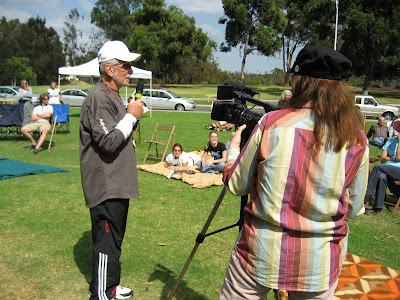1. A fed crew is a happy crew. On most full-day shoots, the client/ producer provides lunch, or at least time for the crew to go out and scrounge up some food. Many producers make sure to provide snacks and beverages to crew members in the morning and afternoon. Savvy producers know that they will get far more out of a well-fed crew. We were recently called by a potential client to provide a crew at a local convention. When she mentioned that the crew "would have to work through lunch" we told her to go ahead and call someone else.
2. Do not plot out an overly zealous shoot. When you insist on covering every single booth at a convention like the San Diego Comic-Con which has several hundred booths, you had better re-think your plan. Prioritize what you cannot live without. If you still want to cover a hundred vendors, then give it two or three days. But don't expect a crew to set up a hundred different locations in a day. It's just not in the cards.
3. Line your ducks up in a row. In continuing with the San Diego Comic-Con example, make sure that the interviews you want are either all in one room and spaced well enough apart so that people are not starting to line up in the hallway; or, if you want to catch the interviewee at their booth, then plot out each and every one in a logical manner. Do not force the crew to go to Ballroom B on the northwest side of the building and then to the basement on the southeast side of the building, and then back up to the next location half a mile away... Try and remember that your crew is carrying heavy equipment (many times management will not allow mag-liners or rolling carts) and there is no excuse to exhaust a crew due to your poor planning.

"On the Floor" at San Diego Comic Con - a constant parade of humanity
4. Factor in travel time and traffic . If you plan on shooting at several different locations, be aware of how traffic flows during both "rush hours" and do not underestimate how much time you and your production "caravan" could be stuck in traffic. Also allow for set-up time at each location.
5. Communicate constantly. Let everybody in the crew know what to expect on the shoot, and tell them what is on the itinerary. This way, everybody can anticipate what needs to be done, and work efficiently as a team. And there will be no undesired surprises.
The old adage of alluring more bees with honey works very well in the scope of video production. If you are working with a stellar crew, and you treat them like the special people they are, then you will achieve some great results in your production. Conversely, if you treat the crew disdainfully, you will burn through talented people who will then talk to their industry colleagues about how you treated them. With social networking, the word spreads faster and further than it ever has before. Be nice!






 Here I am with a young Kirsten Dunst who had just appeared in "Interview With a Vampire." She was the sweetest person ever and consented to pose with me. Beauty and the Beast, eh?
Here I am with a young Kirsten Dunst who had just appeared in "Interview With a Vampire." She was the sweetest person ever and consented to pose with me. Beauty and the Beast, eh?






















